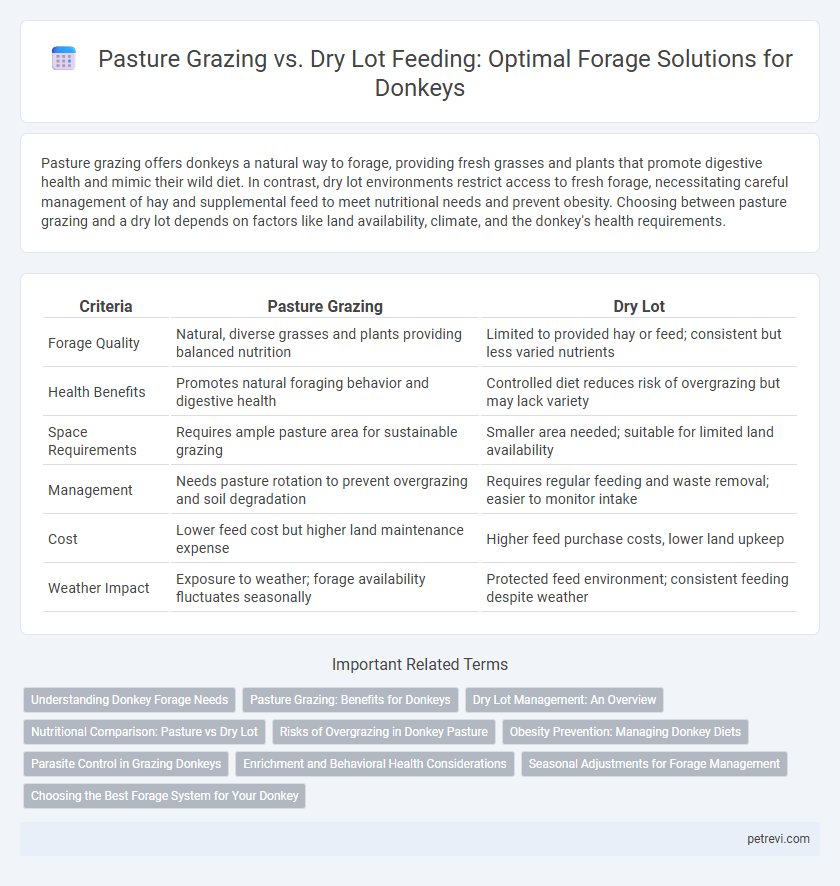Pasture grazing offers donkeys a natural way to forage, providing fresh grasses and plants that promote digestive health and mimic their wild diet. In contrast, dry lot environments restrict access to fresh forage, necessitating careful management of hay and supplemental feed to meet nutritional needs and prevent obesity. Choosing between pasture grazing and a dry lot depends on factors like land availability, climate, and the donkey's health requirements.
Table of Comparison
| Criteria | Pasture Grazing | Dry Lot |
|---|---|---|
| Forage Quality | Natural, diverse grasses and plants providing balanced nutrition | Limited to provided hay or feed; consistent but less varied nutrients |
| Health Benefits | Promotes natural foraging behavior and digestive health | Controlled diet reduces risk of overgrazing but may lack variety |
| Space Requirements | Requires ample pasture area for sustainable grazing | Smaller area needed; suitable for limited land availability |
| Management | Needs pasture rotation to prevent overgrazing and soil degradation | Requires regular feeding and waste removal; easier to monitor intake |
| Cost | Lower feed cost but higher land maintenance expense | Higher feed purchase costs, lower land upkeep |
| Weather Impact | Exposure to weather; forage availability fluctuates seasonally | Protected feed environment; consistent feeding despite weather |
Understanding Donkey Forage Needs
Donkeys require high-fiber, low-protein forage that mimics their natural desert diet, making pasture grazing with native grasses ideal for providing balanced nutrition and preventing obesity. Dry lot feeding allows precise control over forage intake but often requires supplementation with high-fiber hay to meet their digestive needs. Understanding donkey forage needs emphasizes fiber-rich diets with limited sugars and starches to maintain digestive health and prevent laminitis.
Pasture Grazing: Benefits for Donkeys
Pasture grazing provides donkeys with natural forage rich in fiber, supporting digestive health and preventing obesity. Access to fresh pasture encourages natural foraging behaviors, enhancing mental stimulation and overall well-being. Exposure to diverse grasses and plants in pasture helps fulfill essential nutrient requirements more effectively than dry lot feeding.
Dry Lot Management: An Overview
Dry lot management for donkeys involves providing controlled access to high-quality hay and forage, preventing overgrazing and pasture degradation. Proper dry lot setup includes ample shade, clean water, and sufficient space to reduce stress and promote natural behaviors. Regular monitoring of body condition and forage intake ensures donkeys receive balanced nutrition while minimizing risks associated with pasture grazing.
Nutritional Comparison: Pasture vs Dry Lot
Pasture grazing provides donkeys with a diverse range of fresh grasses and legumes rich in fiber, vitamins, and antioxidants, supporting better digestion and nutrient absorption compared to dry lot feeding. Dry lot forage, often consisting of hay or processed feed, tends to have lower moisture content and variable nutrient density, requiring careful supplementation to meet donkeys' mineral and vitamin needs. Nutritional analysis shows pasture forage offers higher omega-3 fatty acids and natural sugars, while dry lot feed can lead to increased risk of obesity if not properly managed.
Risks of Overgrazing in Donkey Pasture
Overgrazing in donkey pasture leads to soil erosion, reduced forage quality, and increased weed invasion, compromising nutritional intake and overall health. Dry lot feeding minimizes these risks by controlling forage availability and preventing pasture degradation. Implementing rotational grazing strategies supports sustainable forage growth and reduces the likelihood of overgrazing damage.
Obesity Prevention: Managing Donkey Diets
Pasture grazing provides donkeys with natural forage rich in fiber, supporting healthy digestion and reducing the risk of obesity by promoting consistent, low-calorie intake. Dry lot feeding allows precise control over diet, limiting access to high-sugar grasses and preventing excessive calorie consumption critical for obese-prone donkeys. Monitoring forage type and quantity in both systems is essential for effective obesity prevention and maintaining optimal donkey health.
Parasite Control in Grazing Donkeys
Pasture grazing for donkeys enhances natural forage intake but increases exposure to parasitic larvae, necessitating strategic rotation and regular fecal egg counts to minimize infestations. Dry lot management reduces parasite risk by limiting access to contaminated grasses, but requires provision of high-quality hay and supplementary nutrients to maintain health. Effective parasite control combines grazing management with targeted anthelmintic treatments based on parasite load monitoring to sustain optimal donkey welfare.
Enrichment and Behavioral Health Considerations
Pasture grazing offers donkeys natural foraging behavior that promotes mental stimulation and reduces stress through varied vegetation and open space. Dry lots limit foraging options but allow focused forage management, reducing exposure to parasites and preventing obesity when forage is controlled. Enrichment in dry lots requires supplemental activities like interactive feeders or toys to support behavioral health and prevent boredom-related issues.
Seasonal Adjustments for Forage Management
Seasonal adjustments in pasture grazing for donkeys require managing forage availability and quality, especially during winter dormancy when pasture growth slows significantly. Dry lot feeding allows precise control of nutrient intake by supplementing hay or commercial feeds when pasture forage is insufficient or dormant. Monitoring forage species composition and adjusting the frequency and duration of grazing sessions ensures optimal forage intake and prevents overgrazing in sensitive seasons.
Choosing the Best Forage System for Your Donkey
Pasture grazing provides donkeys with natural forage rich in fiber, essential for their digestive health, while dry lot feeding allows precise control over diet and prevents overgrazing in limited land areas. Optimal donkey nutrition balances the high-fiber content of pasture grasses with the measured intake of hay or pellets in a dry lot, reducing risks of obesity and laminitis. Considering pasture quality, forage availability, and individual donkey health conditions leads to the best forage system choice that supports their wellbeing and natural grazing behavior.
Pasture grazing vs Dry lot for Donkey Forage Infographic

 petrevi.com
petrevi.com